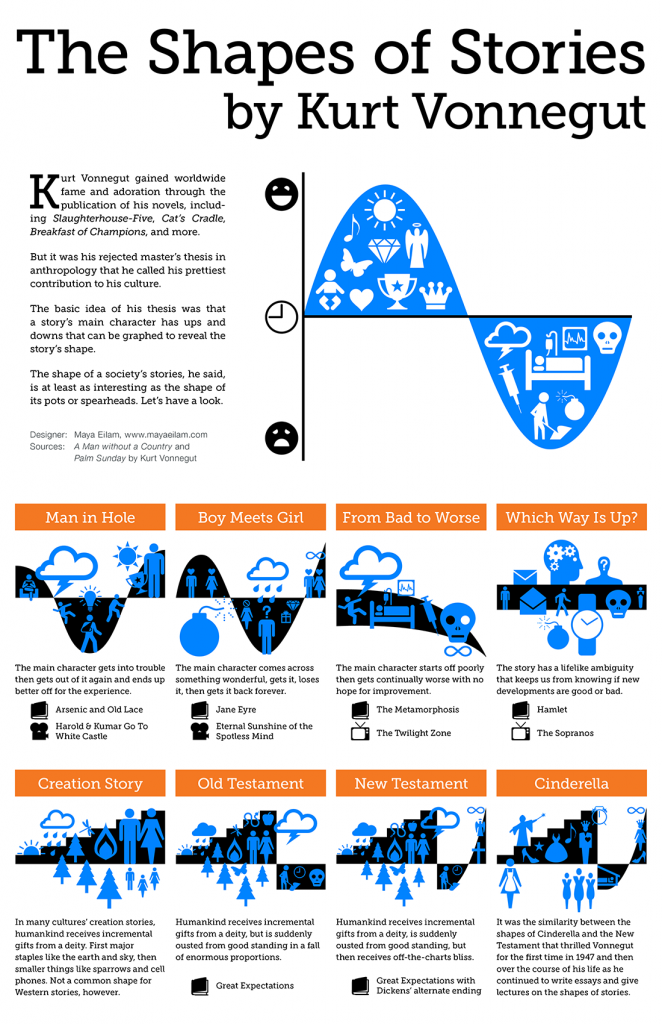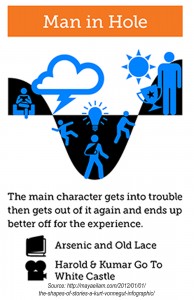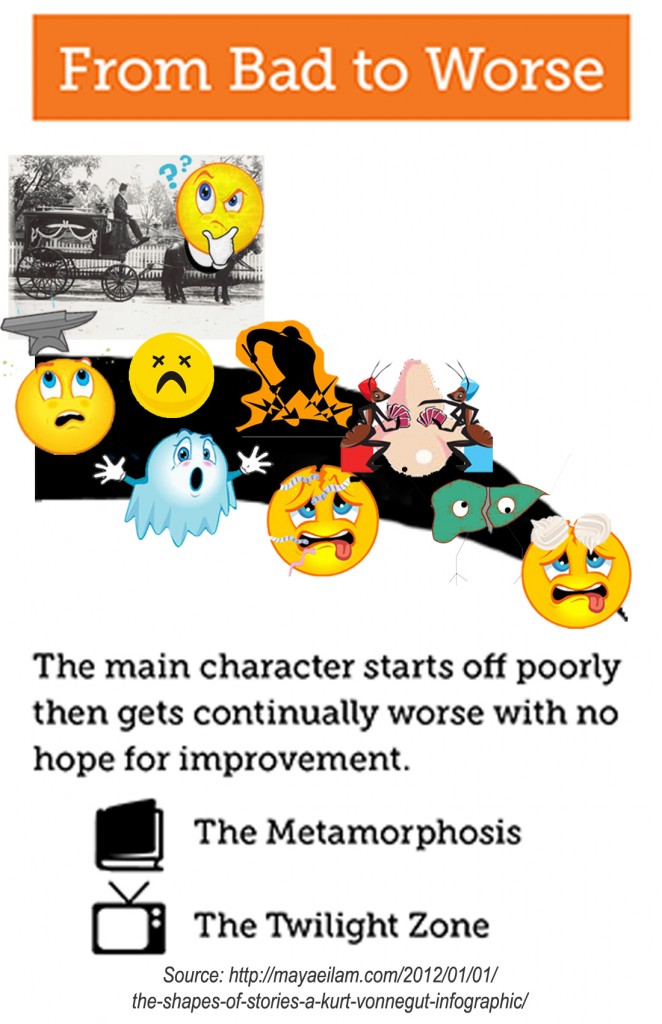DS106 Headless 13 Week 3 was all about the basics of digital storytelling. Part of our assignment was to watch a video of Kurt Vonnegut humorously illustrating his rejected master’s thesis in anthropology that showed how the journey of a story’s main character can be graphed to reveal the story’s shape.
Maya Eilam created an infographic that illustrates these story shapes beautifully with examples we can relate to like: The Twilight Zone, Jane Eyre, and Harold and Kumar Go To White Castle.

Story Shapes Infographic by Maya Eilam
I was glad to see that she had a few more story shapes than what Vonnegut had shown in the short video segment since the story I wanted to use didn’t seem to fit.
After watching this video, write a new blog post and explain a story that you’re familiar with in terms of Vonnegut’s approach. Pick a movie, TV show, book, poem song, etc. The idea is to outline the shape of that story in a visual and descriptive form. Use some kind of media to do this, make it drawing or video or whatever you like. Be creative!
 At first I was going to simply say that my story was a modified “Man In Hole”.
At first I was going to simply say that my story was a modified “Man In Hole”.
But lo-and-behold, my childhood song “The Worms Crawl In” will nicely fit into the “From Bad To Worse” story shape – starting off poorly then getting continually worse with no hope for improvement. For an August DS106 daily create tdc577, my movie trailer for a favorite childhood song or nursery rhyme (embedded at the top of the post) has me singing this song.
As you can clearly hear the poor soul my siblings and I would raise our voices to in song, under the guidance of our mother, was in bad shape and was only getting worse.
“Did you ever think when a hearse went by, that you might be the next to die. They wrap you up in a big white sheet. They bury you down about six feet deep. The worms crawl in, the worms crawl out. The ants play pinochle on your snout. Your liver turns to a slimy green. And puss comes out like whipping cream. Your eyes pop out your teeth decay. And this is the end of a perfect day.”
There is one final uplifting phrase at the end “… and this is the end of a perfect day.” But I think that was just an add-on by some well-meaning parent who needed to make the story shape into the more familiar things-all-work-out-in-the-end “Man In Hole”. 
Come to think of it, there were quite a few stories and songs with the “From Bad To Worse” shape in my youth. Hmmmmmm…. I wonder what Vonnegut’s anthropological lens would have to say about the culture I grew up in? 🙂


“From Bad To Worse” Vonnegut story shape as worms crawl in & out in favorite childhood song #ds106 #talkingheadless13 http://t.co/83cLsNMPuf
You have a lot going on in this post, so I will just address the childhood song. I love how you created a little digital story out of it. I was doubly tickled because my parents and grandparents sang this song around the many campfires of my childhood.
My grandparents were born in the 1880s, so that made me wonder exactly how old this song is. Here is what I learned online:
Information About The Worms Crawl In, Worms Crawl Out
Also known as “The Hearse Song” the song’s origin is hard to ascertain, there have been many different variations using lines similar to “The Worms Crawl In, The Worms Crawl Out”.
The “Gammer Gurton’s Garland” 1810 edition records a nursery rhyme called “There Was a Lady All Skin and Bone” which contained the line “the worms crawled out, the worms crawled in”.
A similar line “The worms, they crept in, and the worms, they crept out” was first recorded in print in the gothic romance novel “The Monk” published in 1796 and contained in the ballad “Alonzo the Brave and Fair Imogine”.
[…] I chose a favorite childhood song that my mother taught us to sing as part of her master plan to keep us kids from fighting, “The Worms Crawl In, The Worms Crawl Out”. […]
3deutsche